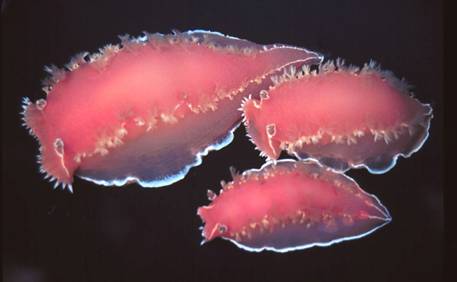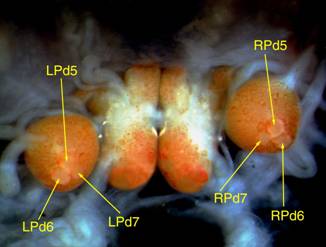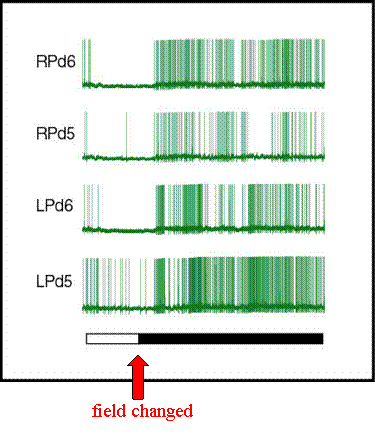Behavioral experiments have demonstrated that diverse animals can sense the Earth’s magnetic field and use it as a cue for guiding movements over both short and long distances. Little is known, however, about the neural circuitry that underlies magnetic orientation behavior.
Most research on magnetic orientation has focused on vertebrate animals such as migratory birds and sea turtles. Although such animals have proven to be excellent subjects for behavioral experiments, they are not ideal for neurobiological research, in part because the complexity of the vertebrate nervous system makes cellular-level investigations of neural circuitry challenging.

The marine mollusc Tritonia diomedea is a nudibranch or sea slug, a kind of snail that has lost its shell in the course of evolution. The animals are found in the Pacific northwest (Washington, Oregon, and northern California) and are common in bays and other coastal areas with relatively few waves. When fully grown, Tritonia can approach 30 cm (about 12 inches) in length, but most individuals are considerably smaller.
The marine mollusc Tritonia diomedea represents a favorable model system for studying how the nervous system detects magnetic cues, processes them, and generates appropriate motor responses. Behavioral experiments have demonstrated that Tritonia can orient magnetically. In addition, this animal has large, individually identifiable brain cells and a relatively simple nervous system amenable to cellular-level electrophysiological analyses.
Intracellular electrophysiological recordings have demonstrated that three bilaterally symmetric pairs of identifiable neurons respond with altered electrical activity to changes in Earth-strength magnetic field. Two of these pairs, known as the Pd5 and Pd6 neurons, are excited by changes in the direction of the ambient field. The third pair, known as the Pd7 cells, is inhibited by the same magnetic stimuli that excite the others. All of these cells presumably function in the neural circuitry underlying magnetic orientation behavior.
The six magnetically responsive neurons in Tritonia represent the first individually identifiable cells known to respond to Earth-strength magnetic fields in any animal. Recent evidence suggests that at least some of these cells are involved in the motor output of the magnetic orientation circuitry. The Pd5 and Pd6 neurons probably control or modulate the activity of cilia on which the slug crawls and thus influence the direction toward which the animal moves. Given the relative simplicity of the Tritonia nervous system, it may eventually be possible to characterize, at the level of individual neurons, the entire neural circuitry that gives rise to magnetic orientation behavior in this neuroethological model animal.

The brain of Tritonia with arrows indicating the locations of the six large, magnetically responsive neurons.

Electrophysiological traces from the four neurons that are excited by changes in the ambient magnetic field. At the time marked by the red arrow, the ambient field was rotated 60 degrees clockwise.
Further Reading:
Baltzley, M. J. and K. J. Lohmann. 2008. Comparative study of TPep-like immunoreactive neurons in the central nervous system of nudibranch molluscs. Brain, Behavior, and Evolution. 72: 192-206. [Download pdf]
Baltzley, M. J., Sherman, A., Cain, S. D., and K. J. Lohmann. 2011. Conservation of a Tritonia pedal peptides network in gastropods. Invertebrate Biology. 130: 313-324. [Download pdf]
Cain, S.D., Wang, J.H., and K. J. Lohmann. 2006. Immunochemical and electrophysiological analyses of magnetically responsive neurons in the mollusc Tritonia diomedea. Journal of Comparative Physiology A. 192: 235-245.
Cain, S. D., Boles, L. C., Wang, J. H., and K. J. Lohmann. 2005. Magnetic orientation and navigation in marine turtles, lobsters, and molluscs: concepts and conundrums. Integrative and Comparative Biology 45: 539-546.
Lohmann, K. J., and A. O. D. Willows. 1987. Lunar-modulated geomagnetic orientation by a marine mollusk. Science. 235: 331-334.
Lohmann, K. J., A. O. D. Willows, and R. B. Pinter. 1991. An identifiable molluscan neuron responds to changes in earth-strength magnetic fields. Journal of Experimental Biology. 161:1-24.
Popescu, I. R. and A. O. D. Willows. 1999. Sources of magnetic sensory input to identified neurons active during crawling in the marine mollusc Tritonia diomedea. Journal of Experimental Biology 202: 3029-3036.
Wang, J. H., Cain, S. D., and K. J. Lohmann. 2003. Identification of magnetically responsive neurons in the mollusc Tritonia diomedea. Journal of Experimental Biology. 206: 381-388. [Download pdf]
Wang, J. H., Cain, S. D. and K. J. Lohmann. 2004. Identifiable neurons inhibited by Earth-strength magnetic stimuli in the mollusc Tritonia diomedea. Journal of Experimental Biology 207: 1043-1049. [Download pdf]
Willows, A. O. D. 1999. Shoreward orientation involving geomagnetic cues in the nudibranch mollusk Tritonia diomedea. Marine and Freshwater Behaviour and Physiology 32: 181-192.